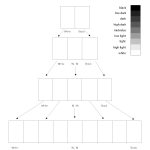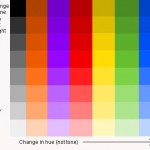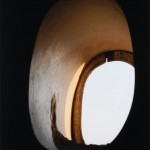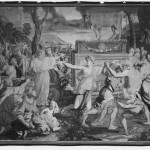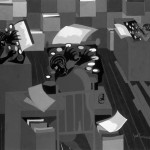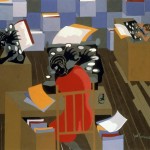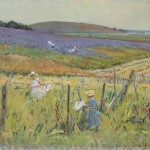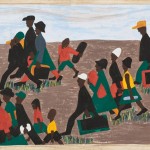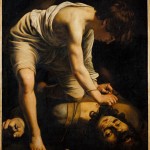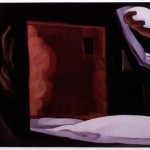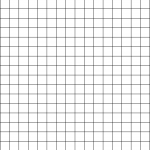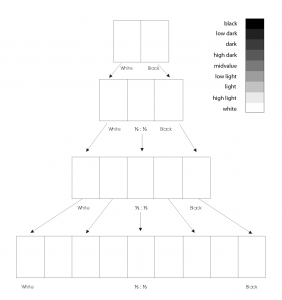October 19, 2015
What’s DUE?
- Combine Phase 3 and 4 feedback/documentation posts for Project #2 into one post. And comment on at least 3 other students animations.
- Complete Humument work for this project
- Using Tom Phillips’ original Humument project as a guide, create a series of pages in your chosen book that demonstrate the concepts we’ve covered in this project:
Line, Rhythm, Repetition, Variety, Pattern - Each page should clearly visually communicate these concepts to your reader/viewer:
- Experiment with blocking out and/or revealing certain areas of text or individual words to communicate your concepts.
- Use pencils, inking pens and (collage) to create your pages.
- Consider trying to create a flipbook animation in one of the corners of the book.
- These should be beautiful objects when complete.
- Using Tom Phillips’ original Humument project as a guide, create a series of pages in your chosen book that demonstrate the concepts we’ve covered in this project:
- Materials Needed:
Critique
- We will review all Animated Mashups from the class blog.
- And Humument work.
Check your grade
- Request a password using the request password link (Password is for this site only)
- Enter your City Tech email and new password on the Check Your Grade page.
- Your grade + comments will be displayed on screen.
- See me with questions or concerns.
Lecture
The Elements: basic components used as part of any composition, independent of the medium.
- Value:Signifies the relative differences of light and dark
- Achromatic: Value with the absence of hue (color) and saturation (intensity).
- Chromatic: Value demonstrated by a given hue.
- Grayscale: The full range of values simplified into a graduated scale.
- Low-Key: When the values of an image are predominately dark
- High-Key: When the values of an image are predominately light
- Narrow Range: When the values congregate around the dark, middle, or light part of the grayscale.
- Broad Range: When the values are spread over the dark, middle, or light part of the grayscale.
- Shadow: Dark area of an object as a result of a disruption of the light source.
- Highlight: Portion of an object that receives the greatest amount of direct light
- Chiaroscuro/Tenebrism: Forceful use of contrasting lights and darks, creating a dramatic mood.
The Principles: basic assumptions that guide the design practice.
- Emphasis: The special attention or importance given to one part of a composition. Emphasis can be achieved through placement, contrast, size, etc.
- Dominance/Hierarchy: The expression of visual and conceptual order that communicates degrees of importance of the various parts of a composition. This can also be achieved through placement, contrast, size, etc.
- Focal Point: The elements or objects on which the viewer’s attention is focused.
- Contrast: Occurs when elements are unrelated or dissimilar in value, size, shape, etc. Increasing contrasts can create dominance.
References:
- High Key
- High Key
- High Key
- Low Key
- Low Key
- Low Key
- Achromatic Value Scale
- Chromatic Value Scale
- Low Key
- High Key
- Jacob Lawrence
- Theodore Wendel
- Jacob Lawrence
- Chiaroscuro
LAB
Value Range Research
- We will take a short walk around City Tech.
- Using your camera or camera phone*, compose 2 photographs with the following qualities:
- (1) predominately within the high-key value range
- (1) predominately within the low-key value range
- If you have the ability to shoot in grayscale, please do.
- Designate a new section of your sketchbook and write ‘Value-Added Portraits’.
- Compose a minimum 2-paragraph description, with specific references to the images, indicating how the key sets the mood of the composition. Also notice and report how the forms in the composition create highlight and shadow relationships; some may be abrupt, others may have a gradation of value from light to dark. How does this contribute expressive quality (mystery, drama, success, joy, etc) of the compositions?
* If you don’t have a camera, please partner with another student who does.
Value Scale
Complete the Achromatic Value Scale using pencils
- On the handout provided, create 4 scales starting with 2 steps and ending with 9 steps ranging from black to white in even, progressive increments.
- Label (in good handwriting) your 9-step value scale with black, low dark, dark, high dark, mid-value, low light, high light, white.
Photo-shoot
- Please come and get your photo taken by the professor (for use in the next project)
- IF you miss this class and didn’t get your photograph taken, contact the professor BEFORE THE NEXT CLASS.
Homework
Complete the following before next class:
VALUE RANGE RESEARCH:
- Post your paragraphs and 2 final images (high key and low key) to the class blog (see Project #3: Phase 1 Guidelines.) Don’t forget to comment on at least 3 other students posts.
- Finish the value scale exercise (print here) we started in class.
HUMUMENT Work:
- Post an image or image gallery of your Humument pages.
- Post title: Humument #2
- Category: Humument
- Tags (some or all, depending on your compositions presented): Line, Rhythm, Repetition, Variety, Pattern
Materials needed:
- Download and PRINTOUT 5 laser prints of your portrait ((DOWNLOAD HERE))
- IMPORTANT NOTE: IF you missed this class and didn’t get your photograph taken, contact the professor BEFORE THE NEXT CLASS.
- Sketchbook, 9×12″ Bristol, pencils, eraser, knife/scissors, ruler/T-square, drafting tape.
- Painting supplies needed for this project (if you haven’t already purchased them)
Field Trip NEXT CLASS:
Meet at 10am at BRIC for a tour of the exhibition “Handmade Abstract” and the facilities.
Print this page 






